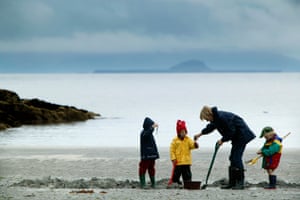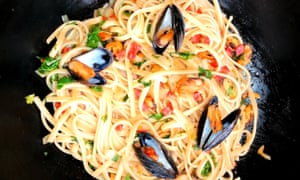Foraging is eco-friendly and anthropologically authentic, but the under-reported (and best) thing about it is that the adrenaline expense of obtaining a food is directly proportionate to the pleasure you get from eating it. I learned this early on, when my mother took me and my siblings to climb the slimy beams under the old ferry pier at Scarinish on the island of Tiree to pick mussels.
These grow below the tideline, so the Atlantic waves washed around our ankles – or our thighs, depending on the sea state. Our mother encouraged us to go when the daily car ferry wasn’t actually docking. But that was chiefly so other tourists wouldn’t spot us and get the same idea.
We spent a lot of time foraging: when I got older, I was surprised to find out that many people on summer break did not spend the bulk of their time searching fields, foreshores and kelp forests for wild food. We trapped lobsters and crabs, and searched out snails, mushrooms, winkles, limpets and – ashamed of this now – seagulls’ eggs, too.
All these we ate with the extra sauce provided by my mother’s assurance that this was food for which snobby people in London restaurants would pay a fortune. And theirs wouldn’t even be fresh! Food was clearly better if you’d risked your skin to get it – and mussel-picking was the most exciting activity of all.
Slipping, clutching the seaweed piles, lacerating our fingers on barnacles, we would gather a couple of buckets of the blue-shelled treasures. They were far bigger than the mussels anywhere else around the island. Then we went back to the holiday cottage for a peak holiday treat: the mussel feast.

Mum would eat the first load of mussels alone “to check they’re safe” – but we reckoned that was just because she was being greedy. She cooked them à la marinière, like the French, boiled and sauced with chopped onions, cream, white wine and a little of the liquor from the mussels themselves. Released from their dark homes, these turned out to be strange pale ivory or almost copper in colour.
But they ate the same, no matter the colour: delicately rubbery, sweet and salty. Now a mussel feast takes me straight back to noisy, sunburned suppers for five hungry children round a little table, a pile of empty shells tottering in a bowl in the middle. Sometimes we’d find a tiny pearl in them.
I still eye up a pier to see if it’s got good mussels on it. On holiday now my children do the climbing – or leap straight off the pier (in wetsuits we didn’t have when I was a kid) – and pull the mussel clusters off the pillars. The cooking has moved on. You can throw mussels, uncleaned, straight on a barbecue, or into a portable smoker, and eat them hot from the shell. You can eat them raw, if you’ve picked them where the water is clean and the currents good and strong: the taste is more interesting than oysters.
Our favourite recipe today takes two ideas from Iberian cooking: first that pork goes brilliantly with shellfish, and second that the liquor – the juice that leaks out when you steam mussels – is one of the best things about them, and you should use it for cooking the rice or pasta on which you bed the golden darlings.
Mussel and chorizo pasta

Serves two
1kg mussels, roughly cleaned – discard any that aren’t tightly closed
1/4 of a chorizo sausage, chopped into small nuggets
1 onion, chopped
3 garlic cloves, chopped
Chilli flakes
200ml white wine
Ground black pepper
200g spaghetti or tagliatelle
Olive oil
Small handful of chopped parsley
Fry the onion and garlic in olive oil till soft. Add the chopped chorizo and a pinch of chilli flakes. Set aside.
Put the wine into a large, heavy saucepan with a tight lid. Bring the wine to a simmer. Tip in the mussels, put the lid on and turn the heat up high. After a couple of minutes, stir and turn over the mussels, then replace the lid. After two minutes more, turn them again.
Pull out a mussel – the shell should be fully open and the flesh just solid enough to hold together when you tear it from the shell. If it is, drain the mussels, retaining the boiling liquid. Sieve that into a medium-size pan, adding just enough water to allow you to cook the pasta. Don’t add salt.
When the mussels have cooled a little, remove them from the shells, pulling away the fibrous “beard” and checking for any bits of grit – but leave a few in their shell to garnish. Add the mussel meat to the onion and chorizo mix, and season with pepper and another pinch of chilli. Lightly heat the mix with a little more olive oil.
When the pasta is al dente, drain it and mix it in with the mussels and sauce. Let it sit for a minute, perhaps adding a couple of spoonfuls of the pasta/mussel water to loosen it. Serve topped with ground pepper and chopped parsley.





